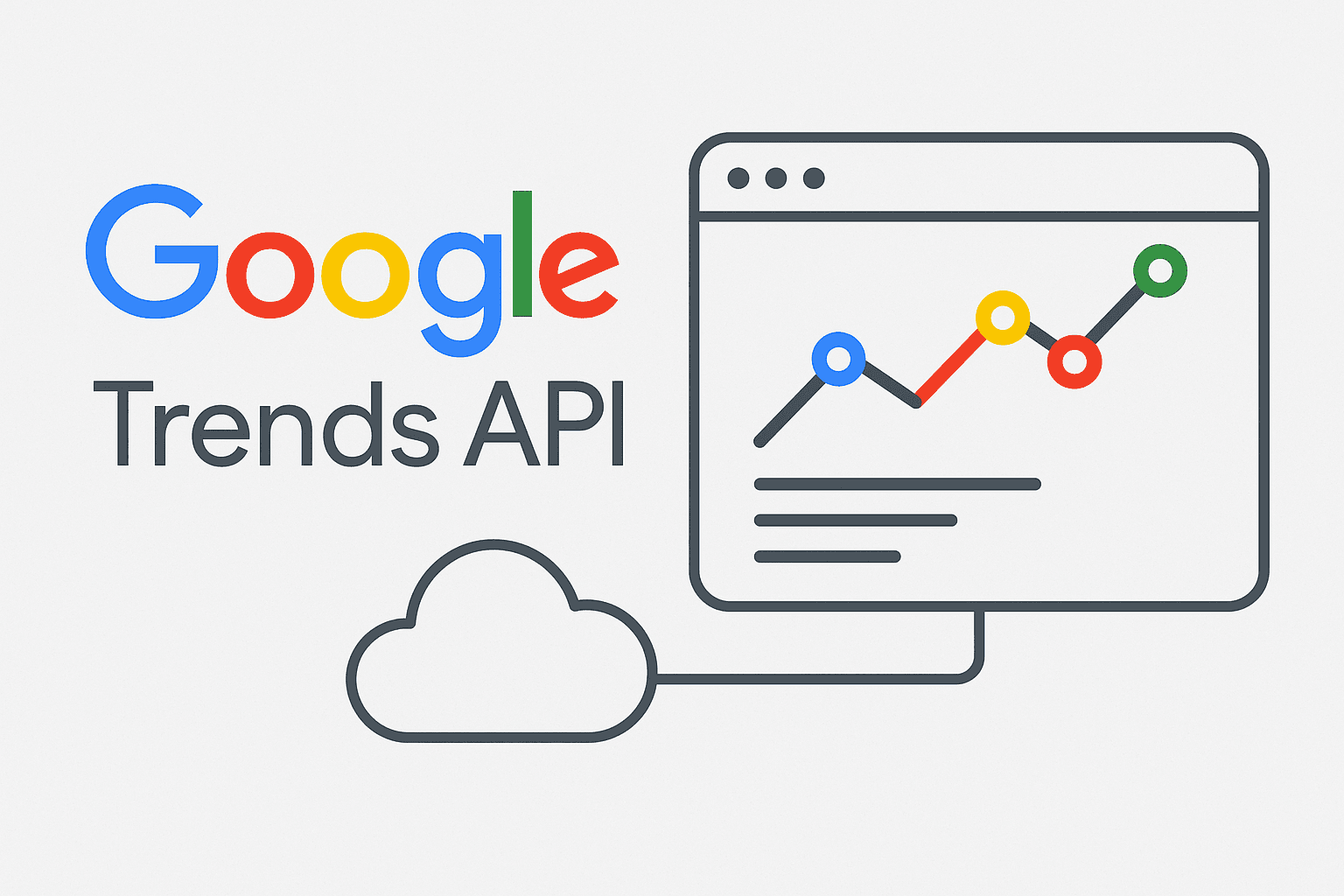Introduction
Google just announced Google Trends API, however by now in Alpha status and not yet opened to everyone.
Until now, accessing this wealth of information programmatically has been challenging. Enter the Google Trends API, a new tool currently in alpha testing that promises to revolutionize how researchers, journalists, developers, and businesses interact with search trend data. This comprehensive guide explores what the Google Trends API offers, how it differs from the existing UI, and how you can become an early adopter of this powerful new resource.
For those looking to enhance their digital strategies, exploring tools like Google Ads or SEO Thailand could provide additional value.
What is the Google Trends API?
The Google Trends API is a programmatic interface that allows users to access Google Trends data directly through code rather than through the web interface. Currently in alpha testing, this API provides developers and data analysts with direct access to Google’s vast repository of search trend information. Unlike the current Google Trends website, which offers a visual, user-friendly interface but limited functionality for large-scale data analysis, the API enables more sophisticated and automated approaches to working with this data.
At its core, the Google Trends API democratizes access to consistently scaled search data. This means users can perform more complex analyses, create custom applications, and integrate Google Trends data directly into their workflows and systems. It represents a significant step forward for anyone seeking to understand search behavior patterns at scale.
For instance, marketers can leverage Content Marketing strategies to utilize insights derived from the API effectively.
Key Features of Google Trends API
The Google Trends API introduces several groundbreaking capabilities that extend far beyond what’s possible with the current UI. Some of the most notable features include:
Consistently Scaled Data
One of the most significant advantages of the Google Trends API is access to consistently scaled data. Unlike the current UI, which normalizes data to a 0-100 scale within each query, the API provides data with consistent scaling across queries. This enables more meaningful comparisons and trend analysis across different time periods and search terms.
Enhanced Comparison Capabilities
The API allows users to compare dozens of terms simultaneously, dramatically expanding upon the current UI limitation of five terms per comparison. This feature is particularly valuable for researchers and marketers tracking multiple keywords or product categories.
Efficient Time Range Extensions
With the API, users can extend time ranges without having to reprocess historical data. Since the data isn’t scaled from 0 to 100, you can simply pull search interest for the most recent period when monitoring trends over time. This represents a significant efficiency improvement compared to the UI, where you would need to pull the entire period for each new request.
Seamless Data Integration
The API makes it possible to join, compare, and merge data from multiple requests. This capability supports more sophisticated analyses and makes it easier to integrate Google Trends data with other datasets or systems.
Businesses might consider using Data Security Compliance measures to protect the data gathered through such integrations.
Benefits for Different User Groups
The Google Trends API offers unique advantages to various professional groups:
For Researchers
Academic and market researchers gain the ability to collect and analyze search data at scale, allowing for more robust studies of consumer behavior, public opinion, and societal trends. The consistent scaling enables more accurate time-series analysis and cross-topic comparisons.
For Journalists
Data journalists can access search trends programmatically to support investigative reporting and data-driven storytelling. The API makes it easier to track breaking news, monitor public interest in specific topics, and identify emerging trends more efficiently.
For Developers
Software developers can integrate real-time or historical search trend data directly into applications, dashboards, and other digital products. This opens up new possibilities for creating tools that leverage search behavior insights.
For Businesses
Marketing teams and business analysts can automate trend monitoring for brands, products, and competitors. The ability to track more terms simultaneously and merge data from different queries enables more comprehensive competitive intelligence.
Incorporating Ecommerce Marketing strategies can help businesses make the most of these insights.
How to Get Early Access to the Alpha
Google is currently accepting applications for alpha testers of the Google Trends API. The company is prioritizing developers who:
- Have specific use cases in mind
- Can begin implementation soon
- Are willing to provide detailed feedback on their experience
To apply for the alpha test program, interested users need to complete Google’s application form. The selection process appears to be focused on identifying testers who can help verify functionality and provide constructive feedback to improve the API before wider release.
The alpha testing phase is critical for Google to refine the API’s capabilities and ensure it meets the needs of its intended user base. Early testers have the advantage of shaping the development of this tool while gaining a head start on incorporating it into their workflows.
For those interested in broader marketing strategies, exploring Digital Marketing for Startups could offer additional opportunities.
Potential Use Cases
The Google Trends API enables numerous applications across various industries:
Market Research and Forecasting
Companies can use the API to track consumer interest in products or services over time, potentially predicting market shifts before they appear in sales data. The ability to compare numerous terms makes competitive analysis more comprehensive.
Public Health Monitoring
Researchers have already demonstrated the value of Google Trends data in tracking disease outbreaks and health concerns. The API makes this kind of monitoring more systematic and allows for integration with other health data sources.
Media Content Planning
Content creators can use search trend data to identify topics of growing interest and optimize editorial calendars. The API enables automated alerts when relevant topics begin trending.
Economic Indicators
Economists have found correlations between certain search patterns and economic activities. The API facilitates more sophisticated models that incorporate search behavior as leading indicators for economic trends.
Political Analysis
Campaign strategists and political scientists can track public interest in issues, candidates, and political events, potentially identifying shifts in voter attention before they appear in polling data.
Leveraging Lead Generation Service can help capture potential leads identified through these analyses.
Comparing Google Trends API with the UI
Understanding the differences between the existing Google Trends UI and the new API helps illustrate the value proposition of this new tool:
Scale and Volume
While the UI limits users to comparing five terms at once, the API allows for dozens of comparisons. This represents a significant expansion in analytical capacity.
Data Consistency
The UI normalizes each query independently on a 0-100 scale, making it difficult to compare results across different queries. The API provides consistently scaled data, enabling more meaningful cross-query analysis.
Automation Capabilities
The UI requires manual interaction, while the API supports automated, programmatic access. This means processes can be scheduled, repeated, and integrated into larger workflows.
Historical Data Handling
With the UI, extending a time series requires pulling all historical data again. The API allows users to add new time periods incrementally, improving efficiency for ongoing monitoring.
Integration Potential
The UI provides data visualization but limited export options. The API delivers data in formats that can be directly integrated with other systems, databases, and analytical tools.
Integrating Programmatic advertising can further enhance these capabilities.
Technical Considerations
While specific technical details about the Google Trends API implementation are still emerging during the alpha phase, potential users should consider several factors:
Programming Language Support
The API will likely support standard programming languages and frameworks commonly used for data analysis, such as Python, R, and JavaScript.
Rate Limits and Quotas
As with most Google APIs, users should expect some form of rate limiting or query quotas, especially during the alpha and beta testing phases.
Authentication Requirements
Like other Google APIs, authentication will likely be required, possibly using OAuth 2.0 or API keys managed through Google Cloud Platform.
Data Format and Structure
The API will probably return data in standard formats like JSON or CSV, with consistent structure to facilitate parsing and analysis.
Ensuring proper Data Security Compliance is crucial when handling such data.
Tips for Successful Alpha Application
If you’re interested in becoming an alpha tester for the Google Trends API, consider these strategies to strengthen your application:
Define Clear Use Cases
Articulate specific, concrete ways you plan to use the API. Vague intentions are less compelling than well-defined projects.
Highlight Technical Readiness
Demonstrate that you have the technical capabilities to implement the API effectively and begin testing promptly.
Emphasize Feedback Capabilities
Show how you can provide structured, useful feedback based on your testing experience. This might include your processes for documenting issues or your history with other beta programs.
Connect to Broader Impact
If possible, explain how your use of the API could benefit broader communities or advance understanding in your field.
Future of Google Trends API
While the API is currently in alpha testing, its development signals Google’s recognition of the value of search trend data beyond casual exploration. As the API matures, we might expect:
Expanded Feature Set
Additional functionality could include more granular geographic data, integration with other Google services, or advanced filtering options.
Pricing Models
While pricing details haven’t been announced, Google may eventually offer tiered access levels from free basic access to premium paid tiers for enterprise users.
Developer Ecosystem
Successful APIs often foster ecosystems of tools, libraries, and services built around them. We might see third-party solutions emerge to extend the API’s capabilities.
Exploring Web Design services could complement the use of such APIs.
Conclusion
The Google Trends API represents a significant advancement in making search trend data more accessible and useful for systematic analysis. By providing programmatic access to consistently scaled data, Google is empowering researchers, journalists, developers, and businesses to extract deeper insights from search behavior patterns.
The current alpha testing phase offers an exciting opportunity for early adopters to shape this tool’s development while gaining competitive advantages in their respective fields. As the API matures, it has the potential to become an essential resource for anyone seeking to understand how people search and what those patterns reveal about our world.
Whether you’re conducting academic research, developing data-driven applications, or seeking business intelligence, the Google Trends API promises to unlock new possibilities for understanding and leveraging the collective curiosity of internet users worldwide. The journey from UI to API represents not just a technical evolution but a transformation in how we can harness search data to understand our rapidly changing world.
Apply for the alpha below:
https://developers.google.com/search/apis/trends#apply
For further inquiries, feel free to Contact Us.Al







